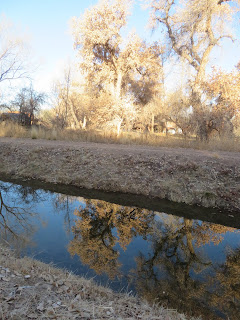Ambedo is the term for being absorbed in a vivid sensory experience. This is usually desirable and pretty easy to find these days in the quiet of an early morning walk in the bosque. While the sounds of car engines is always present, there is stillness if we look for it. In that stillness, details become more vivid.
The bosque preserve is more varied. The biggest trees are all smaller in general, because the competition of close neighbors limits sunlight. However, the trees are younger, and have a wider variety of ages. Age diversity helps reduce extinction risk due to a catastrophic decline (works in human populations, too)
In this mild winter, the canals are refilling quickly even as the drought continues. The new water has little plant growth in it and no animal activity. No ripples, no murkiness. The surface is smooth and reflects the golden trees above them perfectly. The water is dark due to dissolved tannic acids from decaying plant matter. There is no ice or sediment loads to scatter the sunlight.
The beavers prefer heavily overgrown, shallow sections of the ditch to modify. In this picture you can see the still water on the right as the water backs up. The dam captures silt and leaves upstream and releases a small ripple of water. The water reeds are inhibited from growing in the deeper part. The muskrats who share the dam with the beavers prevent establishment of new shoots by eating the young plants.
Beavers are motivated to dam streams by the sound of running water. They seem to prefer very quiet sections of water, and usually chew down the biggest tree trunks to control the growth of trees in the immediate area. They seem to dislike overhanging Russian olive trees, probably because of the leaves. They actually prefer to eat the bark of tree's upper branches with a diameter of a walking stick for food. Often these are stored underwater for later
In more overgrown areas, the overhanging trees shade the water and the duckweed and snotweed grow prolifically. Ducks shelter from predators under the low hanging branches. Weirdly, the abundance of plants and light at the surface means death to the other plants rooted in the mud. The deep shadow below the leaves at the water surface prevent photosynthesis. Worse, the plants will die eventually and bacteria uses up oxygen to digest the remains, causing eutrophication
In the water you can see swirls that mark the passage of feeding ducks as they hunt for aquatic insects hiding in the olive green threads. This area is dominated by snotweed (a type of freshwater filamentous algae). The passage opened by the ducks paddling feet are filled in by the free floating duckweed (a true plant), giving it a different color. The most recent duck paths have less duckweed and so the path seems darker from the shaded water showing through.
Shallow, clear water has abundant sunlight and the water slows down the changes in temperature. Lawn grasses have evolved for this type of climate. There will always be some sort of mosquito fish in these locations, so the water is always rippling.
Areas with trees are very dry right now. The leaves will help retain moisture a little, but they disappear where there is a lot of human activity. This cache of food was dumped in the forest for unknown reasons; ostly likely by campers who had to leave in a hurry.
Most of the area near the Cabezon trailhead is pretty unsightly until you get into the bosque itself. The whole area used to be a landfill. Here, a group of children have collected some interesting old bottles and rusty tins that poked through the leaves.
This is a male Milde's tarantula hawk wasp.It has tattered wings and will soon die. These insects hatch out of the zombie corpse of a tarantula spider. They are not especially prone to stinging. I followed the sound of the buzzing/fluttering for quite a while before I could find it on the ground. Normally they are frantically flying around looking for nectar and females. The bosque was unusually quiet that day and all the sounds were amazingly clear, from the tiny bird flocks, to the wing beats of the low flying cranes. This was the only insect I saw, but pretty remarkable for this time of year.











No comments:
Post a Comment